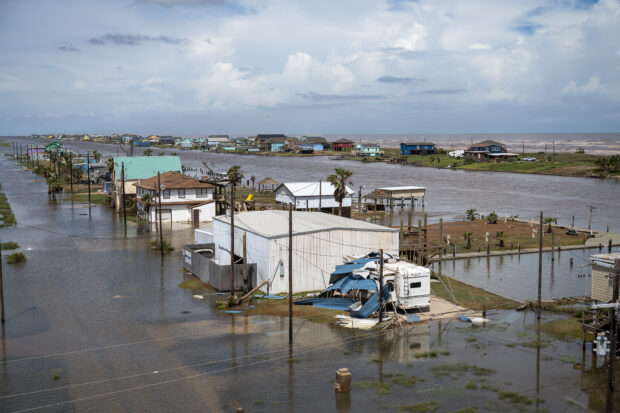Natural catastrophes caused about $62 billion of insured losses in the first half of 2024 — roughly 70 percent above the 10-year average — as extreme wildfires, droughts and floods upend historical norms.
The data, which were compiled by Munich Re, show that “weather catastrophes in the U.S.” dominated losses in the period, Tobias Grimm, the reinsurer’s head of climate advisory, said in a phone interview. Other developments of note include “floods in regions where they are very rare, such as Dubai,” he said.
“It is clear that climate change plays a role in this development,” Grimm said.
Homes surrounded by floodwater after Hurricane Beryl made landfall in Sargent, Texas, on July 8.
In all, natural catastrophes caused $120 billion of losses in the first six months, with little to indicate that the rest of 2024 will offer much respite. That’s as meteorologists predict one of the most active hurricane seasons in recent years, while wildfires raging from California to Alberta have left large parts of North America in shock.
It’s the “longer-lasting heat waves that drive forest fires,” Grimm said.
Meteorological, socioeconomic and underwriting data all point to a changing risk pattern associated with severe weather events, Munich Re said. There’s a greater frequency of storms and fires fueled by climate change, with more built-up areas leading to a bigger risk of property damage.
The upshot is higher claims payments for insurers. The industry has tried to offload some of that risk to capital markets using instruments such as catastrophe bonds. Increasingly, however, there’s evidence that some regions are becoming uninsurable.
Munich Re’s analysis shows that in the U.S., severe thunderstorms caused more than $34 billion of insured damages in the first six months of the year, while total damages from such events amounted to $45 billion. Germany also was hit by costly storms and flooding after torrential rain wreaked havoc in May.
The single costliest natural disaster in the period was an earthquake that rocked the western coast of Japan on New Year’s Day. Buildings collapsed and thousands of people went without power or clean water for weeks, resulting in total estimated losses of about $10 billion. Of that, roughly $2 billion was insured.
Grimm said that “in six of the past seven years, insured natural disaster losses have exceeded $100 billion,” a figure he characterized as higher than historical norms but a level the industry is having to get used to.
Photograph: Homes surrounded by floodwater after Hurricane Beryl made landfall in Sargent, Texas, on July 8, 2024; photo credit: Eddie Seal/Bloomberg





















 Bankers Readying U.S. IPOs at ‘Overwhelming’ Pace Ahead of 2026
Bankers Readying U.S. IPOs at ‘Overwhelming’ Pace Ahead of 2026  Examining 5 Key Factors Fueling MGA Growth—and Emerging Challenges Ahead
Examining 5 Key Factors Fueling MGA Growth—and Emerging Challenges Ahead  U.S. E&S Outlook No Longer Positive: AM Best
U.S. E&S Outlook No Longer Positive: AM Best  The Future of Knowledge in Insurance: From Training to AI-Powered Productivity
The Future of Knowledge in Insurance: From Training to AI-Powered Productivity 




